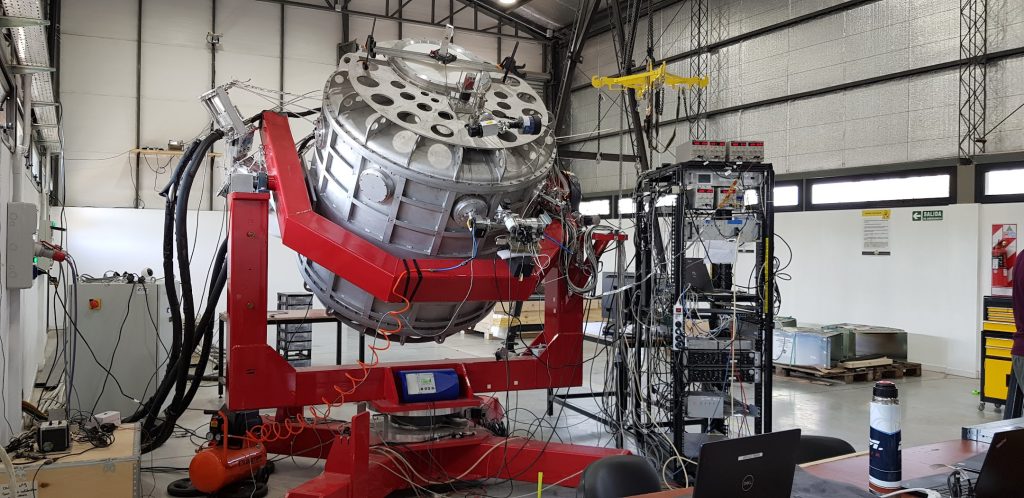
Looking back to the dawn of the Universe to capture and study the residual echo of the Big Bang is the goal of QUBIC: an innovative, ultra-sensitive telescope that will observe the sky from a high-altitude desert site in Argentina from the end of 2022.
QUBIC is the result of the collaboration of 130 researchers, engineers and technicians in France, Italy, Argentina, Ireland and the United Kingdom. Italy plays a key role in the collaboration thanks to the scientific and technological contributions of the National Institute for Nuclear Physics (INFN), University of Milan, University of Milano-Bicocca, University of Rome Tor Vergata and Sapienza University of Rome.
The full name of the project, “Q&U Bolometric Interferometer for Cosmology”, contains a reference to bolometric interferometry, the newly developed technique on which QUBIC’s observations will be based. It combines the very high sensitivity of detectors cooled to almost absolute zero (-273 °C), capable of measuring the energy of the cosmic background radiation by transforming it into heat (bolometers), with the precision of interferometric instruments.
After its development and integration at European laboratories of the universities and research bodies involved in the collaboration, last summer QUBIC arrived in Argentina for the final stages of calibration and laboratory testing. The results of these activities – which confirmed the correct operation of the instrument and the technique on which it is based – were presented in eight articles prepared by researchers of the QUBIC collaboration and published in a special issue of the Journal of Cosmology and Astroparticle Physics.
“QUBIC is an original and extremely complex instrument: for this reason, it was necessary to publish as soon as possible all the details of the hardware and the new techniques to exploit the data collected. Furthermore, the long and exhaustive tests have allowed us to demonstrate the efficiency of QUBIC as a bolometric interferometer in the laboratory. This is a key step before the forthcoming measurements that will impact cosmology and fundamental physics,” explained Silvia Masi, professor at Sapienza University of Rome, INFN researcher and Italian QUBIC coordinator.
The sophisticated telescope will observe and map the properties of the cosmic microwave background focusing on the measurement of particular components of the orientation of fluctuations in cosmic microwave background radiation on the plane of the sky, called B-modes, which are indicative of the possible perturbations induced by gravitational waves generated in the first moments of the Universe.
The extreme sensitivity of this instrument will make it possible to distinguish the details of each of the “pixels” that will compose the map of the sky and to differentiate B-modes from signals generated by other sources in the sky, thus providing direct proof of the Inflation Theory. According to this theory, the extremely rapid expansion of the Universe that occurred immediately after the Big Bang would have left a weak background of gravitational waves that, in turn, would have produced special, very weak traces, called B-modes, in the polarization of the cosmic microwave background.
The choice of the site that will host the telescope is no coincidence: the clear skies and the lack of humidity in the air of Alto Chorrillo will contribute to the accuracy of the measurements. The site where the telescope will be installed is located at around 5000 metres above sea level, on the Puna plateau, near the town of San Antonio de los Cobres, in the province of Salta, northern Argentina.
“QUBIC will be deployed at the Alto Chorrillo site in a few months. The first measurements will demonstrate the efficiency of the novel method of bolometric interferometry by observing astronomical sources for the first time. The instrument will be then upgraded with a larger number of detectors to be able to carry out cosmological measurements in about three years. It is still a long way to go and QUBIC is extremely original and complementary to all the other instruments that are trying to measure this weak primordial signal,” explained Aniello Mennella, INFN researcher and professor at the University of Milan.
The Italian contribution to the project has been and will continue to be significant. The instrument is housed in a cryostat, designed and built in the laboratories of Sapienza University of Rome and the Rome section of the INFN, which can cool the detectors and the entire optical system of the interferometer to temperatures close to absolute zero. The same group also developed the cryo-mechanical system that rotates the optical components inside the cryostat to measure the polarization state of the radiation. Other cryogenic components, which work at temperatures below -270 °C, were also built in Italy, such as the advanced corrugated horns that select the photons to be interfered, produced in the laboratories of the University of Milan and the Milan section of the INFN, while the optical system that focuses the radiation on the detectors and the shutter system that varies the configuration of the interferometer and allows its self-calibration were produced by the University and INFN section of Milano-Bicocca. The University of Rome Tor Vergata and the INFN Roma2 section contributed to the development of the complex data analysis software.

